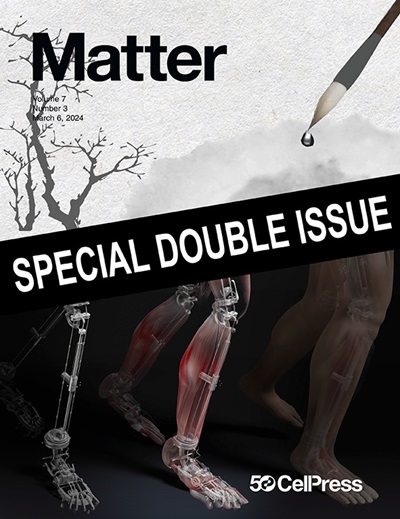Matrix stiffness regulates traction forces, cytoskeletal dynamics, and collagen reorganization in trabecular meshwork cells in glaucoma
IF 17.3
1区 材料科学
Q1 MATERIALS SCIENCE, MULTIDISCIPLINARY
引用次数: 0
Abstract
Increased adhesion forces between trabecular meshwork (TM) cells and the extracellular matrix (ECM) in the human outflow pathway are associated with elevated intraocular pressure (IOP), a key risk factor for primary open-angle glaucoma (POAG). This study examines how matrix stiffness affects traction forces and collagen fibril organization in normal and glaucomatous TM cells using collagen gels with stiffness levels of 4.7 and 27.7 kPa. Normal high-flow (HF) TM/juxtacanalicular tissue (JCT) cells showed greater traction forces on the stiffer gels, whereas glaucomatous HF TM/JCT cells generated greater forces on the softer gels. These differences correlated with findings that normal cells are ∼1.6-fold stiffer than their glaucomatous counterparts. Glaucomatous cells also exhibited anisotropic collagen fibril alignment and distinct cytoskeletal dynamics. These results suggest that altered mechanosensitivity and ECM reorganization in glaucomatous TM cells may contribute to promoting ECM stiffening, elevated IOP, and disease progression, highlighting potential therapeutic strategies.


青光眼中基质刚度调节牵引力、细胞骨架动力学和小梁网细胞中的胶原重组
人流出通道中小梁网(TM)细胞和细胞外基质(ECM)之间的粘附力增加与眼压升高有关,眼压升高是原发性开角型青光眼(POAG)的关键危险因素。本研究使用刚度水平分别为4.7 kPa和27.7 kPa的胶原凝胶,研究基质刚度如何影响正常和青光眼TM细胞的牵引力和胶原纤维组织。正常高流TM/关节旁组织(JCT)细胞对较硬的凝胶产生较大的牵引力,而青光眼HF TM/JCT细胞对较软的凝胶产生较大的牵引力。这些差异与正常细胞比青光眼细胞硬1.6倍的发现相关。青光眼细胞也表现出各向异性的胶原纤维排列和不同的细胞骨架动力学。这些结果表明,青光眼TM细胞的机械敏感性和ECM重组的改变可能有助于促进ECM硬化、IOP升高和疾病进展,强调了潜在的治疗策略。
本文章由计算机程序翻译,如有差异,请以英文原文为准。
求助全文
约1分钟内获得全文
求助全文
来源期刊

Matter
MATERIALS SCIENCE, MULTIDISCIPLINARY-
CiteScore
26.30
自引率
2.60%
发文量
367
期刊介绍:
Matter, a monthly journal affiliated with Cell, spans the broad field of materials science from nano to macro levels,covering fundamentals to applications. Embracing groundbreaking technologies,it includes full-length research articles,reviews, perspectives,previews, opinions, personnel stories, and general editorial content.
Matter aims to be the primary resource for researchers in academia and industry, inspiring the next generation of materials scientists.
 求助内容:
求助内容: 应助结果提醒方式:
应助结果提醒方式:


